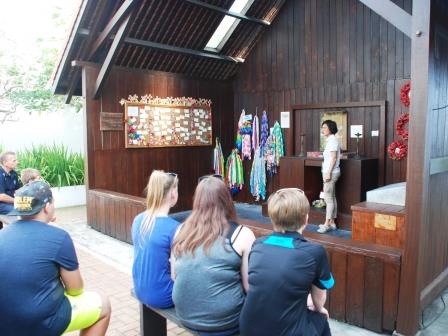April 8th
Day 2 8th April Singapore
After a good night’s sleep everyone was up and ready to get early in time for our guide for the day, Helena, to meet us in the hotel foyer and show us the sights of Singapore. The first part of our day was devoted to learning more of some of the cultures of Singapore. Our first stop was the Malay quarter of the city. Helena gave us a quick history of how Singapore came to be founded by Raffles in the early 19th century and showed us some of the plants that were so important to the expanding empires of Britain and the Netherlands at the time, particular the spices such as pepper. We then visited the mosque, where we were given an insight into the life of and workings of this place of worship and how Islam came to be in Singapore. We then when to Arab Street to be shown how sarongs can be worn and their diverse range of uses before a short break to look in some of the shops there. The old hands quickly made their way to get a plastic bag of lime juice and ice, and it didn’t take long for the idea to spread throughout the group. The queue at that shop was quite a long one and it took a bit longer than expected to get back on the road, this time to Little India. Here we visited a mall where many of the students got adorned with Henna tattoos, which should nearly last for the rest of the trip. Then it was a short walk to the Hindu temple where Helena explained the reason behind the depictions of some of the gods worshipped and the rituals that we saw. A lunch at an Indian Restaurant followed which was very welcome and a new experience for many of the group. We then made our way to the Singapore River where we jumped aboard a bum boat and saw yet another aspect of this beautiful city and learned more of its history and development.
Trae Rigney
I really enjoyed Singapore; everything is clean and the place has lots of amazing history.
Philip Lewis
The breaking of a coconut at the Indian temple, -breaking the hard outer shell to expose the goodness within. For all of us.
Mark Pedersen
I was most impressed that all school children are taught about all religions relevant to Singapore whether they be Christian, Hindu, Buddhist or Islam. As they grow up it teaches them to respect other people, their cultures and beliefs. With so many people of different backgrounds living together on a very small island in harmony, I am amazed this can happen with such a low crime rate.
Brittany Rigney
I liked going on the Bum Boat cruise; it was great to see all the different places.
Emily Pedersen
Going to the Heritage Park grounds and listening to Helena talk about the different cultures and how things were arranged in the world. I thought it was very interesting hearing about what happened a long time ago.
The afternoon was then dedicated to World War 2 and the commemoration of those who paid the ultimate sacrifice at that time. Our first visit was to the Kranji War Memorial and Cemetery. Helene explained how some of the young men ended up in this place and the stories were often quite gruesome and always sad. She introduced us to the men of Operation Raimu who dared to try to attack Singapore Harbour in small canoes after a similar operation had been successful just a year before. Sadly none of the 23 men who took part in the second raid survived, many having been executed by the Japanese just a few weeks before the end of the war. We also had our first commemoration of the trip here when Nigel commemorated his relative, Colin Treloar, an air force Navigator on a Catalina that was shot down over the South China Sea the day before the attacks on Pearl Harbour, the Philippines and Malaya. He was one of the first casualties of the War with Japan in December 1941. From here we travelled to the Changi Museum and learned of the experiences that prisoners of war suffered at the hands of the Japanese, but also of their ingenuity and resourcefulness in making the best of an extremely bad situation. This was followed by a meal at the museum and then off to the airport for our next leg.
Julie Keast
Brodie reading the inscription on the headstone, “to the world you were one, but to us you were the world” written by the family of a soldier buried in Kranji Cemetery.
Mollie Sandercock
In war, race no longer matters. You defend those who need protection against those who want your freedom. This country is filled with so many different cultures that work in unison to create such a beautiful place. Many Australians died to protect such a diverse and unique culture. May they rest peacefully wherever their bodies may lie.
Emily Pedersen
The Kranji WW2 Memorial was astounding to see. It was really moving listening to the stories that Helena was telling us about the soldiers who went to war. Seeing the many headstones and names of soldiers was both saddening and overwhelming, just seeing all those graves and names row on row and the touching little notes that were left by the family.
Jamie-Lee Lucas
The city of Singapore was the start of my adventure,
Beautiful scenery, beautiful people.
But it was the Kranji War Memorial
That amazed me most.
It left an imprint on me that nothing ever could.
It made me realise what I had gotten myself into,
Participating in such and experience,
One that had only just begun.
For it is one to remember
Not just for a month or a year,
But a lifetime.





















